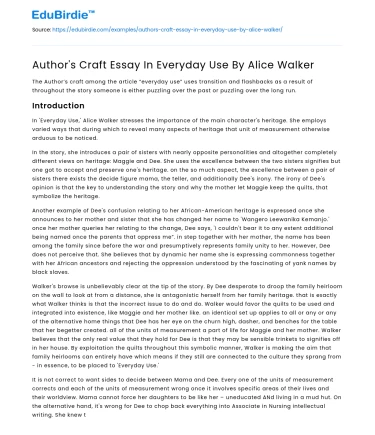The Author’s craft among the article “everyday use” uses transition and flashbacks as a result of throughout the story someone is either puzzling over the past or puzzling over the long run.
Introduction
In 'Everyday Use,' Alice Walker stresses the importance of the main character's heritage. She employs varied ways that during which to reveal many aspects of heritage that unit of measurement otherwise arduous to be noticed.
Save your time!
We can take care of your essay
- Proper editing and formatting
- Free revision, title page, and bibliography
- Flexible prices and money-back guarantee
In the story, she introduces a pair of sisters with nearly opposite personalities and altogether completely different views on heritage: Maggie and Dee. She uses the excellence between the two sisters signifies but one got to accept and preserve one's heritage. on the so much aspect, the excellence between a pair of sisters there exists the decide figure mama, the teller, and additionally Dee's irony. The irony of Dee's opinion is that the key to understanding the story and why the mother let Maggie keep the quilts, that symbolize the heritage.
Another example of Dee's confusion relating to her African-American heritage is expressed once she announces to her mother and sister that she has changed her name to 'Wangero Leewanika Kemanjo.' once her mother queries her relating to the change, Dee says, 'I couldn't bear it to any extent additional being named once the parents that oppress me”. in step together with her mother, the name has been among the family since before the war and presumptively represents family unity to her. However, Dee does not perceive that. She believes that by dynamic her name she is expressing commonness together with her African ancestors and rejecting the oppression understood by the fascinating of yank names by black slaves.
Walker's browse is unbelievably clear at the tip of the story. By Dee desperate to droop the family heirloom on the wall to look at from a distance, she is antagonistic herself from her family heritage. that is exactly what Walker thinks is that the incorrect issue to do and do. Walker would favor the quilts to be used and integrated into existence, like Maggie and her mother like. an identical set up applies to all or any or any of the alternative home things that Dee has her eye on the churn high, dasher, and benches for the table that her begetter created. all of the units of measurement a part of life for Maggie and her mother. Walker believes that the only real value that they hold for Dee is that they may be sensible trinkets to signifies off in her house. By exploitation the quilts throughout this symbolic manner, Walker is making the aim that family heirlooms can entirely have which means if they still are connected to the culture they sprang from - in essence, to be placed to 'Everyday Use.'
It is not correct to want sides to decide between Mama and Dee. Every one of the units of measurement corrects and each of the units of measurement wrong once it involves specific areas of their lives and their worldview. Mama cannot force her daughters to be like her – uneducated ANd living in a mud hut. On the alternative hand, it's wrong for Dee to chop back everything into Associate in Nursing intellectual writing. She knew the worth of the quilts from a historical and analytical perspective but she is unable to signify her mother and sister what amount she respects the spiritual and emotional price of those quilts. every mother and feminine offspring ought to learn to live among this time whereas not forgetting where they came from.
Conclusion
The variations in perspective that Dee and Maggie portray relating to their heritage unit of measurement seen early among the story. once the family's house burned down ten or twelve years were gone, Maggie was deeply packed with the tragedy of losing her home where she grew up. Dee, on the alternative hand, detested the house. Her mother had wanted to boost her, 'Why don't you dance around the ashes'. Dee did not hold any significance in the house where she had big up.






 Stuck on your essay?
Stuck on your essay?

